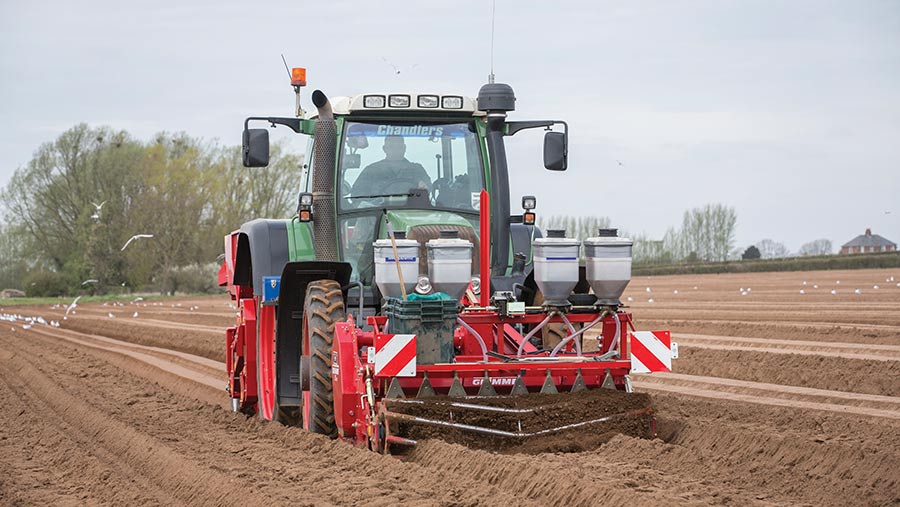5 tips on using Nemathorin to control nematodes in spuds
 © Gary Naylor Photography
© Gary Naylor Photography Growers using Nemathorin for the first time this spring to control nematodes in potato crops are being urged to carefully follow the guidelines on its safe use.
The loss of Vydate (oxamyl) means potato growers have just two options for managing nematodes: Velum Prime which, according to the label, is effective against potato cyst nematodes (PCN), and Nemathorin (fosthiazate), which lists both PCN and free living nematodes on the label.
See also: All you need to know about controlling wireworm in potatoes
This will mean some growers will be using Nemathorin to tackle nematode infestations for the first time.
However, there are key differences in the application of this alternative for PCN control, and getting it wrong could not only reduce efficacy but also increase the risk of residue.
There are five key areas to consider before using the product this spring.
1. No in-furrow approval
Michael Tait, field technical manager at Syngenta, which markets Nemathorin, says one big difference from Vydate is that it does not have in-furrow approval.
“Growers, therefore, cannot use in-furrow applicators on the planter,” he said. “The best approach is to incorporate it during the bed-tilling process, as you will get an even incorporation in soil.”
It can also be applied in the destoning process, but it must be evenly incorporated in the soil, which is more difficult with this approach.
Incorporation must be immediately before or at the time of planting potatoes, he adds.
2. Good incorporation
Mr Tait recommends incorporating to a depth of 15cm.
The label rate is 30kg/ha of product for PCN control and for reduction of spraing caused by free-living nematodes; and 15kg/ha for reduction of damage caused by wireworm.
“With such a small amount relative to the large volume of soil in a hectare, getting good, even incorporation in the rooting zone is essential for good control,” he says.
He advises growers to check the effectiveness of incorporation by first carrying out the rice test.
“Sprinkle 1kg of rice over a 1.5m length of the working width and run the bed tiller or cultivator over the area. Then dig down to see if the rice grains are evenly distributed in the soil and to the required depth.”
This may reveal if the tiller needs to go deeper/shallower, or an uneven distribution of rice grains may indicate that the rotor or forward speed needs changing. Then repeat after changing the machine settings until you are satisfied with distribution.
Mr Tait advises carrying this out at the start of the season and then again after changes are made, such as when using a different tractor or moving to another field, as different soil types may affect incorporation.
3. Correct cartridge and calibration
The applicator consists of a hopper containing the granules on top of a cartridge that meters the product, which falls on to the soil just prior to being incorporated.
“Growers who previously incorporated Vydate on the bed tiller must ensure they have installed the correct cartridges for Nemathorin, as they differ,” he says.
Machines need to be inspected and calibrated at least every two years with a specialist National Sprayer Testing Scheme (NSTS) company. However, it is also worth calibrating annually and checking machinery regularly during planting.
A key time to check is about 2ha after installing new metering cartridges – “after they have bedded in” – just to ensure they are still delivering the right amount.
“First, check if the levels in the hoppers are the same. You may see one with less or more product, showing it is delivering a different relative amount to the other applicators.”
Then, Mr Tait advises checking that the pack has covered the right area. Is there more product left over than expected, or is it running out too soon?
Hygiene is also important, as any debris making its way into the hopper can lead to premature wear of the cartridge, he explains.
Also replace the cartridges when they reach the end of their lifespan, or earlier if they become damaged or worn.

© Blackthorn Arable
4. Observe harvest interval
Another major difference from Vydate is the harvest interval of Nemathorin, which is 119 days, regardless of whether the 30kg/ha or 15kg/ha rate is used. This applies from planting to burndown of the crop, or until lifting if you are green-top lifting.
“For growers supplying early market potatoes, they need to be conscious of this and adhere to this label requirement,” he stresses.
If the growing period is shorter, they can’t use the product, he says.
The Syngenta website provides a handy online harvest interval calculator.
5. Record keeping
The industry set up the Nematicide Stewardship Programme (NSP) to ensure a best-practice approach across all aspects of granular nematicide use.
This includes an industry protocol for granular nematicide best practice:
- Operators should have a PA4 and PA4G qualification
- Machinery must be professionally calibrated at least every two years
- Apply and fully incorporate nematicides within a single pass
- Applicators must have the facility to shut off granule flow before the row end
- Bury small spillages immediately
- Check treated fields 24 hours after application for adverse effects to wildlife.
More information is available on the NSP website and read Syngenta’s guidelines.

